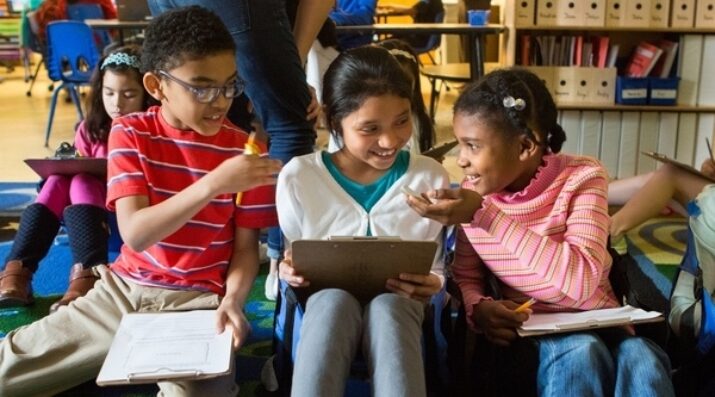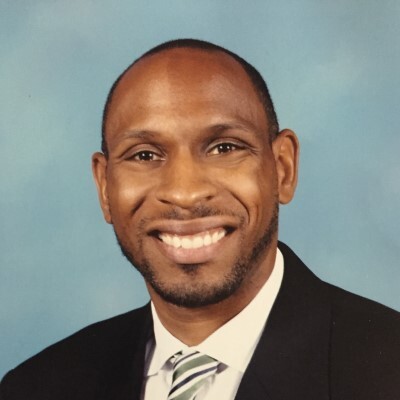Designing for Equity
Beyond the Back-to-School Student Survey: Culturally Responsive Teaching All Year Long
Topics

Together, educators are doing the reimagining and reinvention work necessary to make true educational equity possible. Student-centered learning advances equity when it values social and emotional growth alongside academic achievement, takes a cultural lens on strengths and competencies, and equips students with the power and skills to address injustice in their schools and communities.
Discover five ideas to embrace culturally responsive and inclusive learning in all its complexity to help students develop a sense of belonging, academic success, and a critical worldview.
At some point in their training, most teachers hear this advice: Hand out a start-of-school survey! These documents (or other exercises) are valuable opportunities to learn about students’ likes and dislikes, family and community, interests and passions. Teachers eagerly read them when they are fresh, excited to learn about their new students…and then the meat of teaching begins. In the midst of focusing on fractions and phonics, it’s hard to know what to do with those surveys.
At Relay Graduate School of Education, where I am the dean of teacher programs, we train aspiring and new teachers in culturally responsive and inclusive teaching. Some might assume this means talking about students’ holidays, reading books with diverse characters, or weaving students’ favorite music into lessons. Those can all indeed be positive practices. But it’s also much deeper than that.
We define culturally responsive and inclusive teaching as a holistic approach to instruction that ensures our mindsets and actions recognize students’ cultures, languages, identities, and life experiences as assets, and that we leverage those assets to create a sense of belonging, promote academic success, and develop a critical worldview. Such a positive regard for students is the bedrock of relationships; relationships form community; and community creates belonging. Belonging opens up the safety and joy needed to learn new ideas and skills. Scholars Zaretta Hammond and Geneva Gay have written extensively on this subject, and we build on their ideas. In her book Culturally Responsive Teaching and the Brain, Hammond explores how relationship-building reduces students’ fight or flight reflexes—those tricky psychological barriers that keep them from learning.
Importantly, understanding students’ identities means consistently going behind first impressions, labels, and assumptions. It’s about inviting students to share what’s truly important to them—especially the values, customs, and interests which may not be visible. It’s not about a set of strategies, but an entire mindset shift that influences everything we do as educators. And therefore, it’s not just a back-to-school strategy but a practice that should be reflected in the culture of the school, all year long.
Becoming a culturally responsive and inclusive educator must start with understanding your own identity.
The need for this has become only more clear as we grapple with the recent increase in student behavioral concerns, stagnation in academic achievement, and a pervasive sense of disconnection. As we design next gen schools for the 21st century, teachers, leaders, and professional learning institutions need to understand how to go beyond the survey and embrace culturally responsive and inclusive learning in all its complexity. Here are some ideas for how to do so.
Start with Yourself.
Becoming a culturally responsive and inclusive educator must start with understanding your own identity—including that which is visible and invisible to others. This may include aspects like your race, ethnicity, gender identity, sexuality, nationality, family structure, language, faith tradition, (dis)ability, or socio-economic background. It also includes your values, passions, struggles, and key life experiences. How do you define your identity? What parts might be difficult for others to see? What assumptions might others make about you? For example, if you saw me in my previous role, you might see a Black man who must be middle class because he is leading a school and wears a suit everyday. You might never know that my faith as a Christian and my experience losing my parents at the age of 13 play important—if not primary—roles in my identity. By exploring what is truly important to me, I lay the groundwork for understanding the complexity I will witness in my students.
To do this kind of self-exploration, you may try writing a mini-memoir/life story, doing something like this Identity Worksheet or My Values exercise, or collecting a few objects and writing or recording audio about why they’re important to you. Ideally, you wouldn’t do this work alone, but with a community of educators with whom you can share ideas, reflect, and push your thinking. We guide aspiring and novice teachers through these exercises in the very beginning of their Relay training, but also intentionally return to the concepts repeatedly throughout all of their coursework.
Get to Know Your Students—Then Use What You Know.
Don’t get me wrong—start-of-school surveys are a great tool, and there are many ways you can accomplish the same idea that aren’t just pen to paper. Try having students bring in a photograph of a family member and talk about their connection to them; give students time to decorate their name tags or notebooks with their passions and values; or do an exercise where students move around the room in response to questions about themselves and elaborate on their responses with one another.
Be aware that students will not, nor should not, be expected to open up their most difficult and personal details in the very beginning of the year. Nor would you! Think back to your own self exploration, and consider the layers of disclosure you’re comfortable with. This can be a helpful guide to what you can ask about in the beginning, though you should also consult colleagues and pay careful attention to your students’ responses to you—not everyone will have your same boundaries. As you develop trust, students may choose to open up more to you over time. The key is that we must continue to be curious about our students and find diverse ways to learn about our students throughout the year.
You are the teacher, but your students bring a wealth of life experiences that create your classroom.
Then comes integration. As you create lessons, incorporate your students’ interests, values, communication styles, favorite people, and familiar places into your lessons. They can form the basis of problem-solving activities, influence your reading list, or provide context for science experiments. For example, when Relay alum and 2023 DC Teacher of the Year Jermar Rountree teaches health education, he first asks students to predict the prices of healthy vs. unhealthy foods. He then takes them to local restaurants and grocery stores to compare their predictions to reality, explore the economics of food, and discuss how community shapes the way we see food. This powerful lesson resonates because it allows students to grapple with what they see around them.
And this is not just about lesson plans. Understanding your students should influence how you structure your classroom environment and even how you interact with students on a daily basis. It is a constant process of learning and growth.
Focus on Assets.
You are the teacher, but your students bring a wealth of life experiences that create your classroom. Start planning lessons, experiences, and interventions by considering your students’ strengths. What do they (as a group and individually) enjoy and excel at, and how can you build on this foundation to push their learning into new, more challenging territory? This may be especially important when students present with behavior challenges. Focusing on their strengths will allow them to feel successful and engaged at school and create an opening to problem solve whatever other supports they need.
Just as importantly, keeping a relentless focus on assets helps you, as an educator, remain positively engaged with your job. At Relay, we talk with our graduate students about “the danger of the single story”—i.e., the story we create about others based on their identity or a behavior pattern. Based on that single story, we may resort to a checklist of actions, or sink into despair about a child’s prospects. But no one—starting with yourself!—is a single story. When we keep students’ assets at the forefront, we reclaim our own joy and creativity.
For Leaders: Create the Culture.
This work is far more powerful when it is embraced by leadership and deeply embedded in school and district culture. Leaders model culturally responsive and inclusive behaviors and create space and support for teachers to do their part. As a school, district, or network leader, you can ensure teachers have plenty of time to form relationships and set up classroom culture at the beginning of the year, before jumping to content. As the year progresses, you can also protect time for teachers to build relationships through an advisory or affinity group structure and encourage relationship-building throughout lessons or even non-teaching time, like lunch or hall duty.
Leaders also set the tone during group discussions of student success. Dr. Noah Angeles, the principal of York Early College Academy in Queens, New York, has set up “Kid Talk Tuesday” meetings where the explicit goal is “to problem solve around supporting a student who may not be showing up as their best self.” One student was having trouble staying calm in class, so the team connected him with band and piano lessons. Now, when he has trouble, he goes to a nearby music room to play some music. Dr. Angeles says, “It would calm him down, and then he goes back to class.” This is a great example of the asset-focused approach: in order to address the student’s challenge, the team encouraged and leveraged one of his strengths.
Most importantly, this approach must extend to adult culture—self-exploration, prioritizing relationships, seeing past the visible to each person’s unique experience and assets. Leaders can model this through how they structure the weekly schedule and even provide teachers with avenues for rest and reset during the school day.
For Professional Learning Institutions: Model Culturally Responsive and Inclusive Learning.
All of this starts with teacher preparation programs and professional learning institutions—those of us entrusted with supporting the next (and current!) generation of educators. We must protect time in our programs to explore identity, learn about the history and patterns of power and inequity in schools, build authentic relationships, and connect our courses back to the lived experiences of our teachers—in this case, the work they do in classrooms day by day. When we model the same behaviors we ask teachers to use with students, we see teachers as full humans with their own story, struggles, and assets. This approach should be embedded throughout the curriculum and reflected in the way we advise and coach teachers.
With this shift in practices and mindsets, we can turn a simple student survey from a mere exercise into just the first step in building authentic relationships with students, promoting their academic success, and fostering the critical thinking skills they will need to build a better future for themselves, their communities, and the world.
Photo at top by Allison Shelley/The Verbatim Agency for EDUimages, CC BY-NC 4.0.




